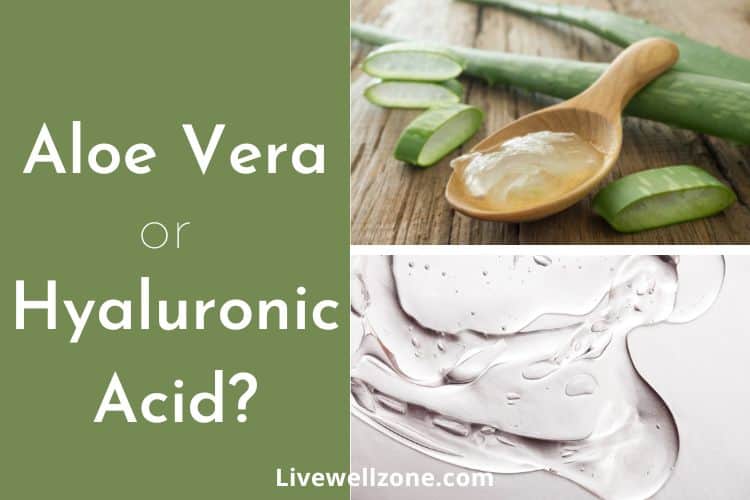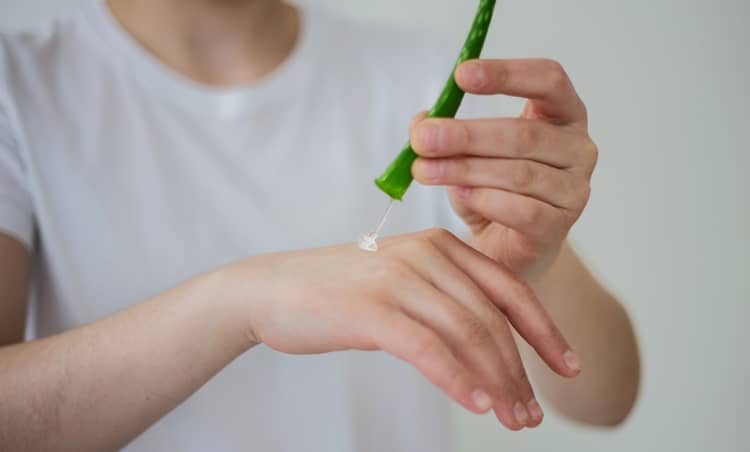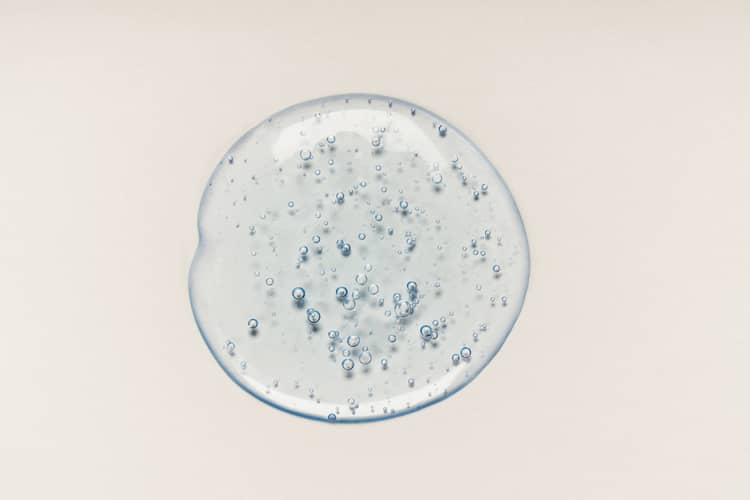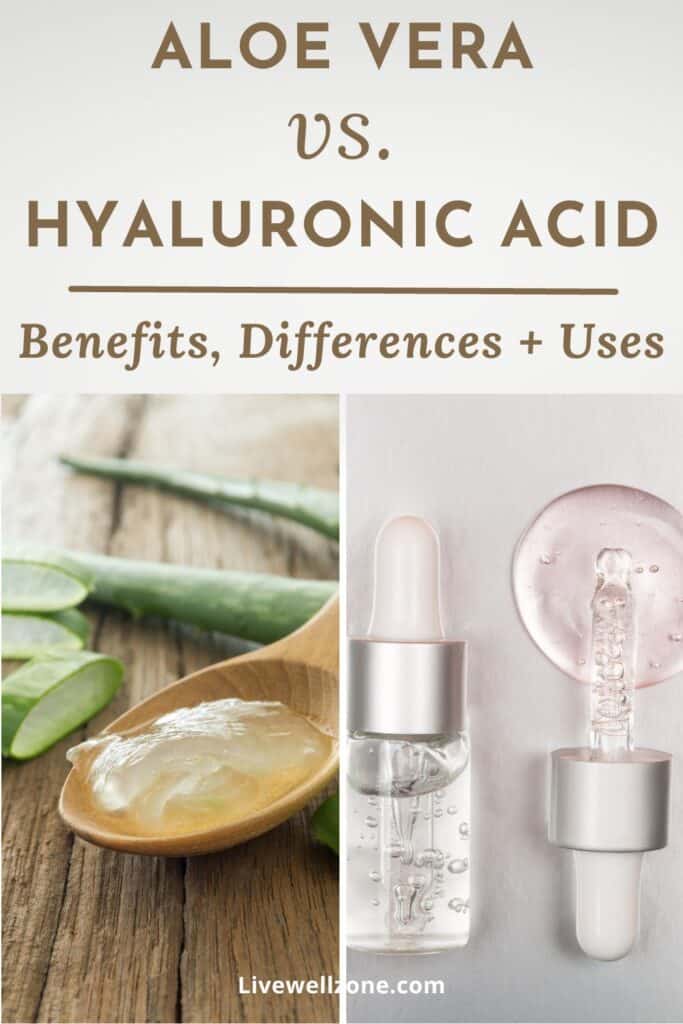
Even though aloe vera and hyaluronic acid are both super hydrating gels, there are some massive differences in terms of what they can do for the skin. So, in this article we’re going to look at aloe vera vs hyaluronic acid, highlighting exactly what makes each one unique, as well as how to add them to your skincare routine.
But before we go any further, let’s be clear about the following:
Hyaluronic acid is a hydrating, gel-like sugar that is found in food and the body (including the skin and joints. Aloe vera is a nutrient-rich, plant that contains various therapeutic compounds (including some hyaluronic acid). In addition, aloe vera has the ability to stimulate the body’s production of hyaluronic acid (source).
Now that we’ve got that very basic understanding of these ingredients, let’s look at their benefits.
Note: this post contains affiliate links and I earn a commission (at no additional cost to you) if you use them to make a purchase.
| Aloe Vera | Hyaluronic Acid | |
|---|---|---|
| Hydrates the skin | ✓ | ✓ |
| Boosts hyaluronic acid production | ✓ | |
| Boosts collagen and elastin production | ✓ | |
| Supports skin barrier function | ✓ | ✓ |
| Protects against sun damage | ✓ | |
| Natural humectant | ✓ | ✓ |
| Exfoliant | ✓ | |
| Rich in vitamins, minerals and sterols | ✓ | |
| Improves hyperpigmentation | ✓ |
ALOE VERA GEL VS HYALURONIC ACID: MAIN BENEFITS FOR THE SKIN
Aloe Vera Benefits (1, 2, 3, 4, 5, 6, 7, 8)

Very hydrating and moisturizing: Aloe vera gel has a very high water content that is great for replenishing moisture in all skin types. In addition, the plant contains long-chain sugar molecules called mucopolysaccharides which are humectants that draw water to the skin.
Boosts collagen, elastin and hyaluronic acid: when used topically or taken internally, aloe vera has the ability to stimulate fibroblasts. These fibroblasts are cells that are responsible for the production of hyaluronic acid, collagen and elastin. As a result, aloe can be helpful for reducing wrinkles, improving the appearance of aging skin and restoring lost moisture to the skin.
Exfoliates the skin: aloe contains various enzymes – such as amylase, bradykinase and alkaline phosphatase – that naturally exfoliate the skin, helping to reveal healthier and smoother skin. In addition, aloe contains amino acids that soften the skin, further helping to improve the overall appearance of skin.
Helpful for acne and acne scars: aloe vera is a natural source of salicylic acid, an anti-inflammatory and antibacterial ingredient that is used in many popular acne remedies (source). In addition, the exfoliating enzymes in aloe help to support skin renewal, which can also help scars. Furthermore, aloe has anti-inflammatory properties which can be beneficial for preventing acne flare-ups.
Protects against sun damage: applying aloe to the skin triggers the release of an antioxidant protein called metallothionein. This antioxidant scavenges free radicals and plays a role in preventing UV-related damage to the skin.
Improves Wound Healing: some studies show that patients with burn wounds who were treated with aloe recovered faster than those who were treated with 1% silver sulfadiazine (an antibiotic cream that is used for wounds). In addition, aloe has been shown to speed up the re-epithelialization process, which results in the regeneration of the epidermis (the outer layer of skin).
Loaded with nutrients: Aloe contains about 75 different components, including:
- Zinc (natural astringent that helps to tighten pores).
- Vitamins A (in the form of beta-carotene), C and E which all have antioxidant properties and support skin renewal.
- B-vitamins like B12 and folic acid.
- Minerals like zinc, selenium, potassium and manganese.
- Plant sterols (including campesterol and beta-sitosterol) which have anti-inflammatory and emollient properties. These sterols also seem to be responsible for increasing the production of collagen, elastin and hyaluronic acid.
- Lupeol and cinnamonic acid, which are natural antiseptics.
Natural remedy for hyperpigmentation: with ingredients like vitamins A and C, as well as exfoliating enzymes, it’s no wonder that some people use aloe vera as a natural remedy for hyperpigmentation. Furthermore, aloe contains aloesin, a compound that has been shown to improve discoloration caused by UV rays.
Hyaluronic Acid (HA) Benefits (9, 10, 11, 12, 13, 14, 15, 16)

Supports skin structure: hyaluronic acid is a mucopolysaccharide that supports collagen and elastin, which are the main proteins that make up the skin matrix.
Natural humectant: hyaluronic acid binds water and can hold up to 1000x its weight. This makes it an essential compound for keeping the skin hydrated. Caution: topical hyaluronic acid can draw moisture out of your skin if you live in a low humidity environment
Improves overall appearance of the skin: topical use of HA can improve the appearance of wrinkles, dermatitis and redness. In addition, HA injections can also be used to plump the skin and give it a more natural glow. As for HA supplements, they can also help to support healthy skin as we age. Since the body’s production of HA naturally decreases with age, supplements may help to compensate for the decline.
Improves wound healing: applying HA to wounds has been shown to reduce pain and the size of the wound. In addition, HA regulates the inflammatory response at the site of a wound and sends signals that increase blood supply to the wound (which helps with wound healing).
HOW & WHEN TO USE ALOE VERA AND HYALURONIC ACID IN YOUR SKINCARE ROUTINE (PLUS DIY SERUM TIP)
How to Use Aloe Vera On Skin
- use the fresh gel from the plant or a store-bought jelly daily. Just be aware that the jellies always have added ingredients, such as perfume, thickening agents and preservatives.
- if you have access to the fresh plant, simply scoop out the gel and rub (smear!) directly onto clean skin. Let the gel sit on your face for up to 15 minutes, then rinse off with warm water.
- you can combine aloe vera with skin-loving essential oils and carrier oils (like jojoba and grapeseed oil). However, if you are using fresh aloe, you will need an emulsifier (it allows you to blend water and oils). Otherwise, you can use a store-bought aloe jelly that already contains an emulsifier. Here’s an unscented aloe vera jelly from Plant Therapy that you can use for this.
How to Use Hyaluronic Acid (HA) On Skin
- use daily (up to twice a day if needed) to keep the skin moisturized.
- apply HA to clean skin (after using your toner, if applicable). Follow up the HA with a moisturizer and/or face oil to lock in the moisture.
- look out for products that contain “sodium hyaluronate” in the ingredients. This is a synthetic form of hyaluronic acid. It can temporarily plump the skin and give it a dewy appearance, but it’s not the same as true hyaluronic acid. This particular could potentially be pro-inflammatory for some people.
- if you enjoy the process of making your own products, then you can even make your own hyaluronic acid serum at home. To do this, follow the DIY tutorial below from Marie at HumbleBee and Me. She’s a DIY expert!
FAQs ABOUT USING ALOE VERA OR HYALURONIC ACID
What should you not mix with hyaluronic acid?
Overall, hyaluronic acid seems to play well with other skincare ingredients and there are no known negative interactions. That is not to say that there are no interactions – just that there’s nothing documented to this effect. To get a customized recommendation of what to you, or not use with hyaluronic acid, it’s best to seek the advice of your dermatologist.
Does hyaluronic acid go on before serum?
Ideally, hyaluronic acid should be applied before your serum, on clean skin. The hyaluronic needs to be applied first to facilitate absorption, while the serum will help to lock in moisture.
Note that you can simplify your skincare routine by using a serum that contains hyaluronic acid. For example, this Mad Hippie Vitamin C Serum contains hyaluronic acid along with other nourishing ingredients like vitamin E and aloe vera.
CONCLUSION
Hyaluronic acid and aloe vera are both great options for hydrating the skin naturally. While hyaluronic acid mainly provides hydration, aloe provides hydration along with potential benefits for acne, dark spots, inflammation and so much more.
Whichever option you choose to use, your skin will thank you 🙂

You Might Also Enjoy:
Vitamin C Serum vs Aloe Vera Gel: Benefits, Differences, Which Is Better and How to Use
Aloe Vera or Shea Butter for Sunburn: Which Is Better?
A Complete Guide to Retinol vs Aloe Vera (and Why You Should Use Them Together)
Honey vs Aloe Vera for Face: Benefits, Best Ways To Use and Recipes
Which is Better: Rosehip Oil or Retinol? A Complete Guide
Rosehip Oil vs Hyaluronic Acid: Benefits, Differences & How To Use Them

